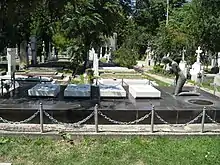Theodor Pallady
Theodor Pallady (Romanian pronunciation: [teˈodor paˈladi]; 11 April 1871 – 16 August 1956) was a Romanian painter.


Biography
Theodor Pallady was the son of Ioan Pallady and Maria Cantacuzino, the older sister of Romanian diplomat Neculai B. Cantacuzino. He was born in Iași, Romania on April, 14th 1878 and spent his childhood both in Perieni and in Iași.[1] At a young age, his family sent him to Dresden, where he studied engineering at the Dresden University of Technology between 1887 and 1889. At the same time, he studied art with Erwin Oehme, who, recognising his artistic intuition, suggested that he go to Paris.[2]
In Paris, Pallady worked in the studio of Edmond Aman-Jean and enrolled in the Academy of Fine Arts (Académie des Beaux-Arts). In 1892 he joined Gustave Moreau’s studio where he worked alongside painters such as Henri Matisse, with whom he developed a close friendship, Georges Rouault, and Albert Marquet.[3]
In 1900, he presented his work "The Prodigal Son", at the Exposition Universelle, which earned him high praise.[2]
In 1906 he married Jeanne Ghika-Brigadier.[4]
He opened a studio in Paris on Place Dauphine, where he worked until 1940, traveling often between France and Romania.[2]
In 1904, Pallady returned to Romania, where he held an exhibition at the Romanian Athenaeum. However, he maintained close connections with Paris, where he continued to hold many personal exhibitions, up until World War II.[5]
Pallady never lost the contact with Romania and had friends from the community of Romanian artists and intellectuals living in Paris, including Benjamin Fondane, George Enescu, Constantin Brâncuși, Camil Ressu, Nicolae Dărăscu, Panait Istrati, Traian Vuia, Eugène Ionesco, Emil Cioran, and Paul Celan. Theodor Pallady bought Brâncuși sculpture The first Kiss, this work is a little kiss (7.8" × 1.18" × 1.57") pink marble, and the first work of modern art. This sculpture is dated 1905 and was brought it with him to Romanian. He also exhibited at the Venice Biennale in 1924, 1940 and 1942.

In 1940 he moved to Bucharest.[1] He died in Bucharest on 16 August 1956, and is buried in Bellu Cemetery.[2]
Legacy
The Melik House, situated in Bucharest houses The Theodor Pallady Museum, a branch of the National Museum of Art of Romania. Here are exposed his canvas paintings, as well as 800 of landscape sketches, portraits, and still life paintings, which are representative of his Paris period. The building, built in 1750 by Hagi Kevork Nazaretoglu, is the oldest house in Bucharest. In front of the museum's building stands a bronze statue of Theodor Pallady, created by the Romanian sculptor Gheorghe D. Anghel.[6] Other works of Pallady's are features of the National Museum's main collection, at Bucharest's Zambaccian Museum, the Palace of Culture in Iași, the Argeș County Museum in Pitești, the Brukenthal National Museum in Sibiu, and the Craiova Art Museum in Craiova.
References
- Georgescu, I.L. (1998). Pe urmele lui Theodor Pallady. Bucharest, Romania: Lumina Lex. ISBN 9735881373.
- "Theodor Pallady, pictorul uitat al Iașului". ziarullumina.ro. Retrieved 4 December 2019.
- Pallady, Theodor (2009). Pallady scriind: jurnale, scrisori, însemnări. Compania. ISBN 978-973-7841-67-4. OCLC 741721824.
- Chiper, Mihai (2016). Pe câmpul de onoare: o istorie a duelului la români. Bucharest: Humanitas. ISBN 978-973-50-5471-7. OCLC 1108180328.
- Enescu, Theodor (2003). Pallady, Theodor. Oxford Art Online. Oxford University Press. doi:10.1093/gao/9781884446054.article.t064896.
- "Muzeul Theodor Pallady - Bucuresti". www.ghidul.ro. Retrieved 4 December 2019.